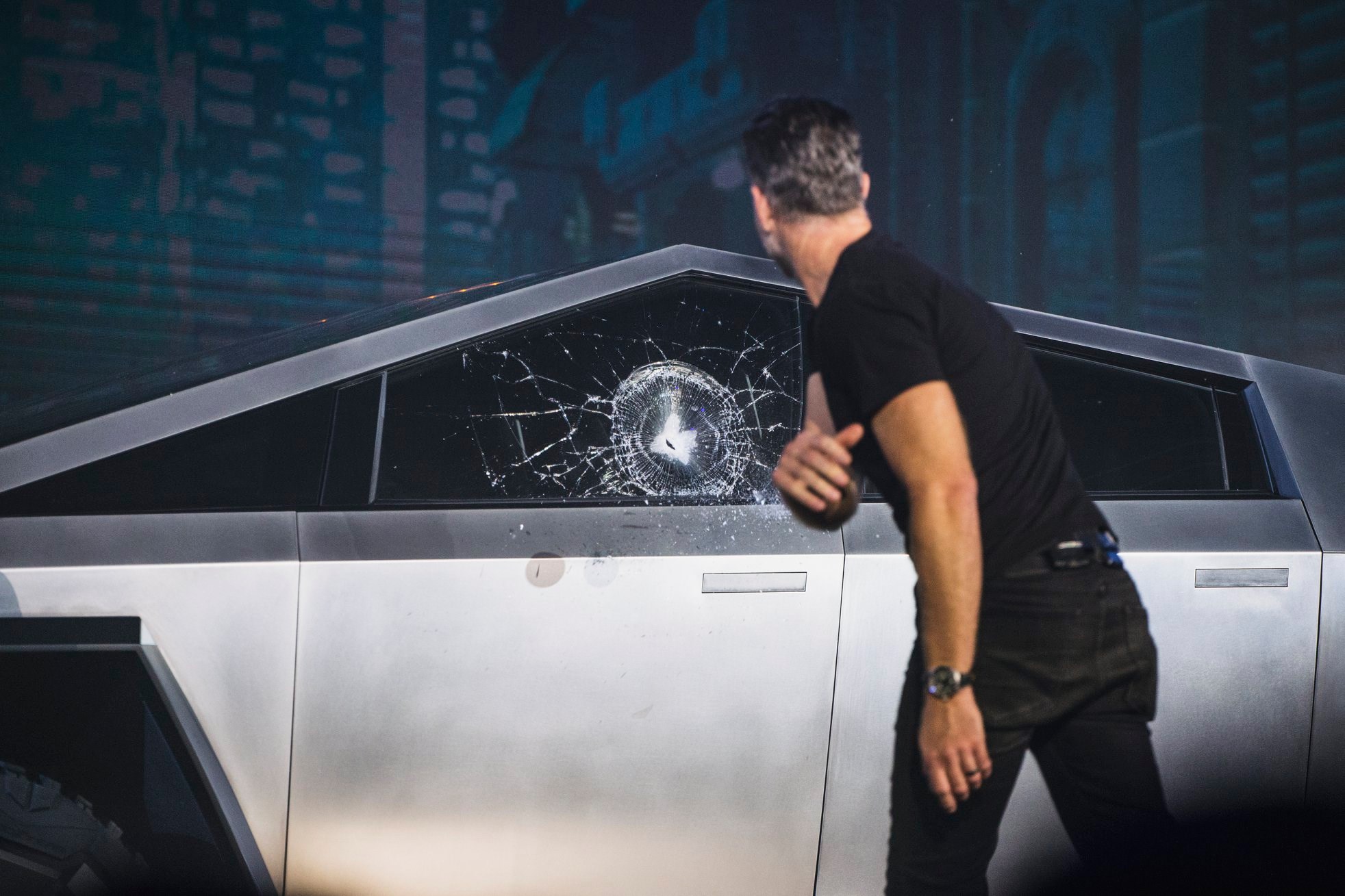It’s been less than two months since Tesla CEO Elon Musk revealed the Cybertruck–a vehicle that Musk described as an “armored personnel carrier from the future.”
Even if you didn’t watch the event live, you probably heard about its most dramatic moment. In an effort to demonstrate the strength of the vehicle’s windows, which Musk described as a “transparent metal glass,” Tesla design chief Franz von Holzhausen threw a metal ball at both the front and rear windows of the Cybertruck. Unexpectedly, the glass shattered both times.
The scene went viral, becoming an instant meme. Critics seized the moment to poke fun at Musk, who had touted the Cybertruck as “bulletproof” and said that customers were ready for “a truck that’s really tough, not fake tough.”
But rather than attempt to downplay the viral moment, Musk and company have decided to embrace it by announcing its newest product: a t-shirt depicting an image of the Cybertruck’s shattered glass.
If you’re surprised by this marketing play, you shouldn’t be. As fellow Inc. columnist Minda Zetlin so aptly put it, selling t-shirts to commemorate the cringeworthy moment is “a classic Elon Musk move.”
It’s also a lesson in emotional intelligence.
What’s emotional intelligence got to do with it?
Emotional intelligence is the ability to identify, understand, and manage emotions–both your own, and those of others. Put more simply, it’s the ability to make emotions work for you, instead of against you.
So, how does the sale of a t-shirt celebrating an epic fail qualify as Musk making emotions work for him?
Chances are, your initial reaction to the Cybertruck window break, and even to the Cybertruck itself, is directly influenced by your opinion of Tesla’s chief executive. That is, you either believe:
Musk is vastly overrated as a company leader, who makes a lot of promises he can’t keep, and whose ideas are too far out there to ever be truly successful.
Or, you believe that…
Musk is a brilliant visionary, who is constantly striving to push himself and others to do the amazing, and who has the potential to change the world.
Obviously, Musk doesn’t care too much about trying to please that first camp.
And while he surely appreciates his fans, he’s not necessarily trying to impress them, either. Rather, his goal is simply to jump the curve.
Famous entrepreneur Guy Kawasaki perfectly described the practice of jumping curves, which he learned from none other than Apple cofounder Steve Jobs: “If you truly want to be an entrepreneur and an innovator, you have to jump curves,” said Kawasaki. “You don’t do things 10% better, you do things ten times better.”
Tesla has become one of the most valuable auto companies in the world based on its ability to jump curves, to make things ten times better (at least in the eyes of some). But you don’t jump curves by imitating the status quo. Instead, you must be willing to take risks, to try new things. Sometimes, those risks will lead to failure.
But out of failure comes learning. And out of learning comes growth.
For example, while initially dumbfounded, Musk later explained the reason why he believed the window shattered during the Cybertruck launch: A few minutes earlier, also live on stage, von Holzhausen had slammed the truck’s door with a sledgehammer to show its durability. Doing so cracked the base of the glass, weakening it and setting it up to break, according to Musk.
“Should have done steel ball on window, then sledgehammer the door,” he continued. “Next time.”
And here is where emotional intelligence comes into play.
By selling this t-shirt, Musk takes ownership of the moment. He keeps it real, and rather than shun or hide from his failure, he celebrates it.
In effect, he tells the world: “Hey, I’m not perfect. Tesla’s not perfect. But we’re trying our best. We’re learning a lot. We’re moving forward.”
“And we’re having fun as we do it.”
And as he moves forward, Musk continues to inspire people across the globe. Like the 250,000 people who deposited a hundred dollars–to be the first potential owners of a vehicle that just had its “unbreakable” glass broken on live TV.
Now that’s what I call making emotions work for you, instead of against you.
Enjoy this post? Check out my book, EQ Applied, which uses fascinating research and compelling stories to illustrate what emotional intelligence looks like in everyday life.
A version of this article originally appeared on Inc.com.


